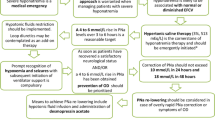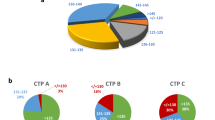Abstract
Background
A high incidence of hypervolemic hypernatremia has been described in patients recovering from acute kidney injury (AKI) in intensive care units. However, this has been limited to only a few cases.
Methods
One hundred fifty adult patients recovering from AKI in the intensive care unit of a single institution during a 6-year period, who developed hypernatremia during the course of their illness, were investigated. Serum and urine electrolytes, osmolality, urea nitrogen and creatinine were measured. The weights of these patients at the time of hypernatremia development and at presentation to the hospital were also measured.
Results
Even though the hypernatremia was mild in most patients (146–160 mEq/L), the average rise in serum sodium concentration was 14.5 ± 7.1 mEq/L. Of the 34 patients who had all urinary studies available, the average urine osmolality was 436 ± 128 mmol/kg of which 172 ± 54 mmol/L was contributed by sodium, potassium and their accompanying anion. Another 204 ± 96 mmol/L was accounted for by urea and creatinine (mainly urea). Almost all the patients had hypervolemia as evidenced by the presence of edema and an average weight gain of more than 9 ± 11 kg between the time of presentation and the onset of hypernatremia despite likely having lost muscle mass from being in the intensive care unit for several days. The weight data were available in 54 patients, and only eight of these patients had lost weight at the time of the development of hypernatremia.
Conclusion
Hypervolemic hypernatremia is by far the most common cause of hypernatremia in patients in the intensive care unit. Even though the patients are in negative fluid balance at the time of the development of the hypernatremia, earlier saline administration has caused massive volume overload despite the ongoing losses. Post-AKI diuresis in the face of inability to maximally concentrate the urine because of renal failure often leads to mainly mild elevations in serum sodium concentration. The urine solute is mainly urea because of the often high serum urea concentrations with little electrolytes being present in the urine.

Similar content being viewed by others
References
Luetscher JA, Blackman SS (1943) Severe kidney and brain injury following sulfathiazole. Ann Intern Med 15:741
Brady HR, Brenner BM (2001) Acute renal failure. In: Braunwald E, Fauci AS, Kaper DL, Hause SL, Longo DL, Jameson JL (eds) Harrison’s principles of internal medicine, 15th edn. McGraw-Hill, New York, pp 1541–1551
Sam R, Hart P, Haghighat R, Ing TS (2012) Hypervolemic hypernatremia in patients recovering from acute kidney injury in the intensive care unit. Clin Exp Nephrol 16(1):136–146
Popli S, Tzamaloukos AH, Ing TS (2014) Osmotic diuresis induced hypernatremia: better explained by solute-free water clearance or electrolyte free water clearance? Int Urol Nephrol 46:207–210
Sam R, Feizi I (2012) Understanding hypernatremia. Am J Nephrol 36:97–104
Prowle JR, Kolic I, Purdell-Lewis J, Talylor R, Pearse RM, Kirwan CJ (2014) Serum creatinine changes associated with critical illness and detection of persistent renal dysfunction after AKI. Clin J Am Soc Nephrol 9(6):1015–1023
Author information
Authors and Affiliations
Corresponding author
Ethics declarations
Conflict of interest
The authors have declared that no conflict of interest exists.
Rights and permissions
About this article
Cite this article
Sarahian, S., Pouria, M.M., Ing, T.S. et al. Hypervolemic hypernatremia is the most common type of hypernatremia in the intensive care unit. Int Urol Nephrol 47, 1817–1821 (2015). https://doi.org/10.1007/s11255-015-1103-0
Received:
Accepted:
Published:
Issue Date:
DOI: https://doi.org/10.1007/s11255-015-1103-0




